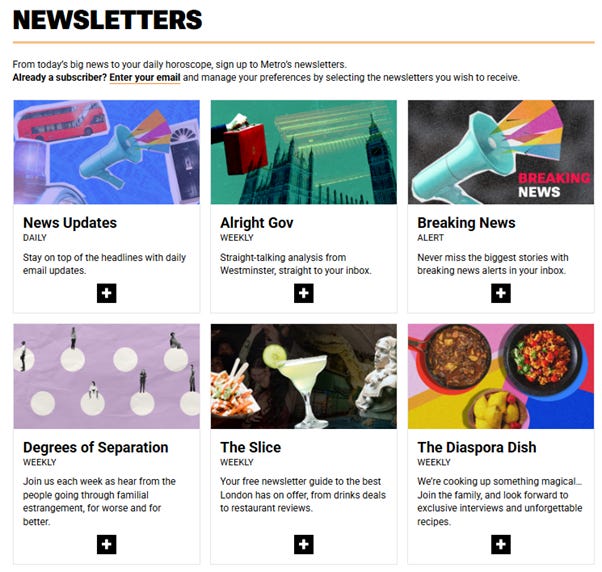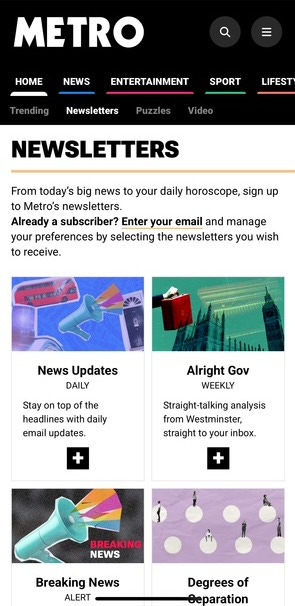How Metro Built 300,000 Newsletter Subscribers Through Personalisation and Platform Experimentation
Head of Newsletters, Sophie Laughton explains how the free commuter paper is using WhatsApp, personalised fact boxes, and print as a funnel to drive double-digit growth.
Read time - 8 minutes
Sophie Laughton runs one of the UK’s most ambitious newsletter operations. The Metro’s Head of Newsletters oversees 17 active titles serving 2.5 million daily print readers and 15 million monthly online viewers.
The numbers tell the story. Metro’s politics newsletter, Alright Gov?, has grown significantly using personalised fact boxes that convert casual readers into subscribers. The approach combines data collection with editorial personality, and readers respond to content that feels tailored to their interests whilst maintaining a human voice. But it’s the platform experimentation that’s generating real momentum.
We’ve seen a 12.5% growth in our WhatsApp channel over the last 30 days, and 50% of our reach comes from people sharing it with friends, rather than through direct Metro distribution.” says Laughton. The platform is helping in their aim to build “small, niche communities” around politics and other topics a different model to the broadcast approach of traditional email newsletters.
For a brand that started as a free commuter paper handed out on the London Tube, London’s underground network, it’s quite a shift. Metro has maintained its non-partisan stance whilst building direct relationships across email, WhatsApp, and now Instagram. That editorial positioning - carefully neutral in an increasingly polarised media landscape - has become a strategic asset.
“It allows us to be balanced and provide a unique perspective,” Laughton says of Metro’s editorial approach. The non-partisan stance gives Metro room to experiment with different newsletter formats and platforms without getting caught in the political tribalism that dominates much of the news industry.
From Web Assistant to Head of Newsletters
Laughton started in student journalism, graduated during the pandemic, and completed a master’s in magazine journalism before landing at Metro as a web assistant. That led to a full-time position and, eventually, to her current role.
The newsletter industry has transformed during her tenure. What were once simple email updates have become sophisticated, personalised content operations. Publishers now see newsletters as relationship-building tools that offer something social platforms can’t: direct, owned access to engaged audiences.
The Redesign That Unlocked Growth
A recent redesign changed how Metro’s newsletter team operates. It wasn’t just cosmetic - it fundamentally altered their ability to test, iterate, and scale.
The redesign improved the way we could design and deploy sign-up points, making us more agile,” says Laughton. Everything came under one cohesive brand, making it easier for readers to understand the offering and giving the team more flexibility in promotion.
Before the redesign, Metro’s newsletters felt fragmented with different visual identities, inconsistent touch-points, and no clear brand architecture. The overhaul brought discipline whilst maintaining the individual character of each newsletter. Readers could now recognise a Metro newsletter product whilst still getting distinct content experiences.
The practical impact was immediate. The team could deploy new sign-up points faster, test different messaging approaches, and cross-promote between newsletters more effectively. Agility matters in newsletter growth - the ability to spot what’s working and double down quickly separates successful operations from those that stagnate.
The real win? Personalised fact boxes that address readers directly with personal touches from the editorial team. “Personalised fact boxes have been effective, especially those with a personal touch, this was a successful initiative supported by our Growth Team ,” Laughton says. These aren’t generic “here’s today’s news” modules. They’re crafted to feel like a journalist speaking directly to the reader, often with context about why a particular story matters or how it connects to previous coverage. That personality-driven approach has become central to Metro’s newsletter strategy.
Newsletter growth depends on multiple, well-designed entry points for potential subscribers. Metro now has those in place across its digital properties, print products, and social platforms.
Using Print to Drive Digital
Metro’s 2.5 million daily print readers are feeding its digital newsletter growth. The physical newspaper works particularly well for sections like horoscopes and puzzles, content that has a natural daily cadence and loyal followings.
“The print product has been a successful funnel for driving people to subscribe to new newsletters like the puzzles newsletter”
The strategy is straightforward but effective. Print readers already engaging with specific content types see clear calls to action for related newsletters. Someone doing the daily crossword in the print edition is a prime candidate for a puzzles newsletter. The behaviour is established; Metro is simply offering a digital extension of something readers already value.
This print-to-digital funnel challenges the conventional wisdom that print and digital audiences are separate tribes. Metro is finding they’re often the same people consuming content in different contexts - print during the commute, digital at other times of day.
The team is exploring how to translate other popular print features into newsletter products. “Rush Hour Crush”, a reader-submitted section about transport crushes (the hopeful romantic type rather than on crowded underground trains), has already found success on TikTok through Metro’s social video team. It demonstrates how content can work across platforms when the core idea is strong enough.
But not everything translates neatly. Some print features work precisely because they’re embedded in the newspaper experience. The challenge is identifying which content has genuine standalone potential rather than forcing every successful print section into newsletter format, commented Laughton.
Multi-Platform Strategy
Metro is launching an Instagram page for its politics newsletter to build the brand and community beyond email and WhatsApp. Each platform serves a different purpose: email for depth, WhatsApp for immediacy and sharing, and Instagram for visual storytelling and brand building.
The publisher is also getting serious about personalisation and segmentation, collecting data to create interest profiles. This isn’t just demographic information - it’s behavioural data about which stories readers engage with, which newsletters they open, and what times they’re most active.
That data infrastructure enables smarter cross-selling. Rather than promoting every newsletter to every subscriber, Metro can invite readers to related newsletters based on demonstrated interests. Someone who consistently opens stories about UK politics might get invited to the politics newsletter. A reader engaging with lifestyle content sees different recommendations.
“It works well when we can personalise the invitation and make it relevant to the reader’s interests”
The cross-selling success depends on editorial collaboration. Metro’s editorial team has become more involved in pitching stories for newsletters and working with the newsletter team to identify content that might drive conversions. That integration ensures newsletters feel like a natural extension of Metro’s journalism rather than a separate product bolted on.
It’s a significant shift from the early days of publisher newsletters, when they were often afterthoughts managed by a single person. Metro’s operation now involves coordination across editorial, product, and commercial teams.
AI for Ideas, Not Content
Metro’s newsletters team uses AI for ideation and subject lines but not for creating content. It’s a deliberate boundary in an industry where AI-generated content is becoming ubiquitous.
“I emphasise the importance of editorial control and the value of having a personal voice in our newsletters”
The distinction matters. AI can help brainstorm angles or test subject line variations, tasks where speed and volume are advantages. But the actual content creation requires human judgment, a voice, and the ability to understand what will resonate with readers beyond pattern-matching.
Metro’s newsletters have built audiences precisely because they don’t read like algorithm-generated content. The personal voice, the editorial choices about what matters, the ability to add context or challenge conventional wisdom, these are human skills that AI can’t replicate convincingly at scale.
The editorial team has become more involved in pitching stories for newsletters and collaborating with the newsletter team. This ensures newsletters benefit from Metro’s broader editorial expertise whilst maintaining their distinct character. A politics newsletter isn’t just republishing content from the website; it’s curating and contextualising news with a specific audience in mind.
What’s Next
Laughton sees the biggest opportunities in building loyal communities and launching series newsletters - time-limited content products focused on specific topics or events.
Series newsletters represent a different approach to audience building. Rather than asking readers to commit to an indefinite subscription, they offer a defined content experience. A six-part series on election coverage, for instance, or a two-week deep dive into a specific policy area or event such as Celebrity Traitors. Readers know what they’re getting and when it ends.
The format could unlock new audience segments - people interested in specific topics who don’t want another permanent inbox commitment. It also gives Metro’s editorial team space to experiment with more ambitious, structured storytelling that wouldn’t fit the daily newsletter format.
There’s also interest in regional newsletters and niche, localised content. Metro’s strength has always been London and commuter audiences, but the newsletter model could allow them to serve other geographic markets or hyperlocal communities. The operational challenges are significant as each regional newsletter requires dedicated resources and local editorial knowledge.
With 17 editorial newsletters now in operation, Metro’s approach has moved from experiment to core strategy. The lesson? Newsletters aren’t just email blasts. They’re branded content experiences that need personalisation, personality, and platform-appropriate distribution.
Whether other publishers can replicate Metro’s success without a 2.5 million print readership to fuel it remains to be seen. That print base provides both audience scale and a testing ground for new newsletter products - advantages many digital-only publishers lack.









